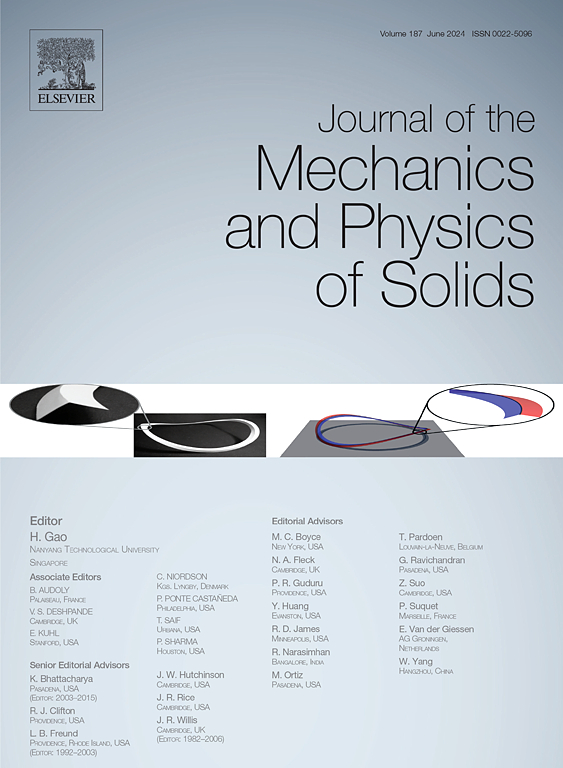Modeling spider silk supercontraction as a hydration-driven solid–solid phase transition
IF 5
2区 工程技术
Q2 MATERIALS SCIENCE, MULTIDISCIPLINARY
引用次数: 0
Abstract
Spider silks have attracted significant interest due to their exceptional mechanical properties, which include a unique combination of high strength, ultimate strain, and toughness. A notable characteristic of spider silk, still debated from both mechanical and functional viewpoints, is supercontraction –a pronounced contraction of up to half its original length when an unconstrained silk thread is exposed to a wet environment. We propose a predictive model for the hygro-thermo-mechanical behavior of spider silks, conceptualizing this phenomenon as a solid–solid phase transition, similar to the glass transition in rubber, but driven by humidity. As wetting increases, the system undergoes a transition, at the network scale, from a hard, dry state –where the material behavior is governed by stiff chains elongated along the fiber axis– to a soft, wet state, regulated by a rubber-like response. We model these states using a two-well free energy function dependent on molecular stretch, with transition energy modulated by humidity. Based on the methods of Statistical Mechanics, we deduce that supercontraction can be interpreted as a solid–solid phase transition. We elucidate the important role of thermal fluctuations. In particular, the decrease of the critical humidity needed for supercontraction as temperature grows results as an effect of entropic stabilization of the softer rubbery phase. Our model quantitatively predicts the observed experimental behavior, capturing the temperature dependence of humidity-induced supercontraction effects and related cooperative properties.
蜘蛛丝超收缩模型为水合作用驱动的固-固相变
蜘蛛丝由于其特殊的机械性能而引起了极大的兴趣,其中包括高强度,极限应变和韧性的独特组合。蜘蛛丝的一个显著特征是超收缩——当一根没有约束的丝线暴露在潮湿的环境中时,它会明显收缩到原来长度的一半,这在机械和功能上都存在争议。我们提出了蜘蛛丝的湿-热-机械行为的预测模型,将这种现象概念化为固体-固体相变,类似于橡胶中的玻璃相变,但由湿度驱动。随着润湿的增加,系统在网络尺度上经历了从硬、干状态(材料行为由沿纤维轴拉长的硬链控制)到软、湿状态(由类似橡胶的响应调节)的转变。我们使用依赖于分子拉伸的双阱自由能函数来模拟这些状态,过渡能由湿度调节。根据统计力学的方法,我们推导出超收缩可以解释为一种固-固相变。我们阐明了热波动的重要作用。特别是,随着温度的升高,超收缩所需的临界湿度降低,这是软橡胶相熵稳定的结果。我们的模型定量地预测了观察到的实验行为,捕捉了湿度诱导的超收缩效应和相关的协同特性的温度依赖性。
本文章由计算机程序翻译,如有差异,请以英文原文为准。
求助全文
约1分钟内获得全文
求助全文
来源期刊
CiteScore
9.80
自引率
9.40%
发文量
276
审稿时长
52 days
期刊介绍:
The aim of Journal of The Mechanics and Physics of Solids is to publish research of the highest quality and of lasting significance on the mechanics of solids. The scope is broad, from fundamental concepts in mechanics to the analysis of novel phenomena and applications. Solids are interpreted broadly to include both hard and soft materials as well as natural and synthetic structures. The approach can be theoretical, experimental or computational.This research activity sits within engineering science and the allied areas of applied mathematics, materials science, bio-mechanics, applied physics, and geophysics.
The Journal was founded in 1952 by Rodney Hill, who was its Editor-in-Chief until 1968. The topics of interest to the Journal evolve with developments in the subject but its basic ethos remains the same: to publish research of the highest quality relating to the mechanics of solids. Thus, emphasis is placed on the development of fundamental concepts of mechanics and novel applications of these concepts based on theoretical, experimental or computational approaches, drawing upon the various branches of engineering science and the allied areas within applied mathematics, materials science, structural engineering, applied physics, and geophysics.
The main purpose of the Journal is to foster scientific understanding of the processes of deformation and mechanical failure of all solid materials, both technological and natural, and the connections between these processes and their underlying physical mechanisms. In this sense, the content of the Journal should reflect the current state of the discipline in analysis, experimental observation, and numerical simulation. In the interest of achieving this goal, authors are encouraged to consider the significance of their contributions for the field of mechanics and the implications of their results, in addition to describing the details of their work.

 求助内容:
求助内容: 应助结果提醒方式:
应助结果提醒方式:


